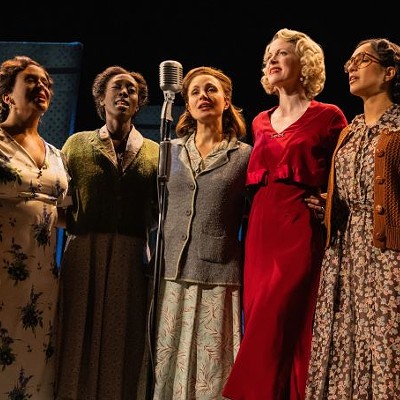Every other character is played by one of four "Chorus" members. The script notes on the Chorus call them "dispassionate but eloquent" and their roles are "vivid, bright, sharp, and distinct." The Chorus plays not only their characters, but also the Chorus member beneath each character.
The play is divided into five acts, and each act sees Bob experiencing interactions and turning points that will drastically change him and his circumstances during the next act. Interludes occur between each act, with one intermission between acts 3 and 4.
The execution:
Right from the start, we see the absurdism in not only the concept of a White Castle burger joint as a safe house to drop off newborns, but also in the appearance of baby Bob himself, who, instead of being played by an infant or a doll, is played by the same actor who plays the adult Bob. The audience can tell that he's a newborn by his fleecy, yellow footie pajamas and wide, vacant eyes.
A great deal of Bob's history is told as flashback so that, for the most part, the audience finds out Bob's origins as he does. At times, the self-discovery is excessive--we learn a lot about Bob's early life and his parents, but very little is said about his life as an old man and what ultimately brings about his change from bitter to hopeful.
The cast, none of whom are theater majors, execute their lines with almost childlike enthusiasm. Despite the best intentions of Paul Dingus (Bob) and a solid performance, Bob still seems like the least-relatable character in the show. Bob is almost too easily-changed by his circumstances and seems to have little substance of his own.
As with many absurdist plays, the lines at times prevent any character development or serious acting--for example, during one character's death throes, she simply says, "I'm dying." It's a nuanceless approach to avant garde theatre that can be effective in some circumstances but comes across in this work as a little too cliché.
The interludes between acts that Nachtreib includes in the script are carried out in this production as dances, one by each member of the Chorus, which represent themes from the play. At times awkward because of the performers' apparent lack of dance training, these were charmingly frank and at times quite amusing.
One thing that truly stands out about director Julia Traber's approach to BOB is the staging and use of black box, in-the-round audience configuration, which adds a new dimension to the role of the Chorus as narrator. They peep around doors or stand in corners of the stage, outside of the action but near to the audience, to whisper clues to the audience when figures from Bob's past reappear.
Mark Krouskop's set is minimal, with a 1950's flair that reminds one of a diner with a long counter and a jukebox that sits picturesquely by any American highway. The blank signs that line the top of the set are used stunningly by projection designers Ian Mellor- Crummey and Lauren Thompson as various settings and other visual aids appear there to tie the scene together.
Lighting designer Steve Pappas easily distinguishes between action and scene changes, and spotlights are used sparingly but effectively to focus on characters' soliloquies. Costume designer Heather Breikjern didn't have a lot of work to do in this show--it looks like the cast mostly wears their own clothes, with occasional accessories to distinguish the each of the Chorus' many characters.
Although Nachtrieb encourages a live performance of original music with the play, sound designer Nigel Deane uses canned music nearly as sparingly as possible--a shame, as Deane is a composition student at Rice's Shepherd School of Music with a rather extensive collection of awards under his belt. His talents could have added a lot to the performance, but were sadly neglected.
The verdict:
While the play tries to have an absurdist, moral-less flavor, it ends on a chintzy note of hope and the human ability for redemption. This attempt to give meaning to a meaningless style of art is, at best, dysfunctional and ill-suited to much of the play's content.
However, the set and directing style is well-matched to the play, and the actors' presentation is filled with such exuberance that the audience can't help but be captured in the tale of Bob. The theater was full of appreciative laughter, despite minor flaws with the script and a prop mustache that simply would not adhere to Bob's face.
BOB: A Life in Five Acts runs through Feb. 21 at Rice University's Hamman Hall, 6100 Main. Visit arts.rice.edu or call (713) 348- 4005 for tickets and information. $5 student tickets, $8 seniors, $10 general admission. Mature audiences only.





